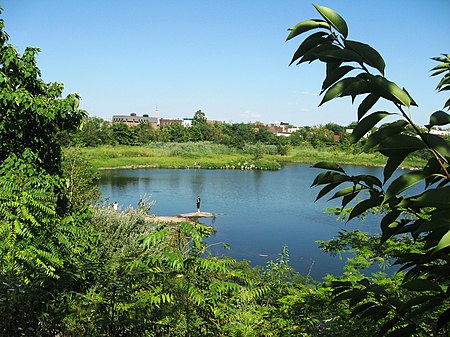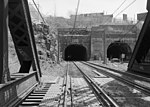Jersey City Reservoir No. 3

Jersey City Reservoir No. 3 is a decommissioned reservoir atop Bergen Hill in the Heights of Jersey City, Hudson County, New Jersey, United States, situated on approximately 13.8 acres (5.6 ha) just south of Pershing Field. It was built between 1871 and 1874 as part of the city's waterworks system designed to provide potable water to the city, including Ellis Island. Its perimeter wall is in the Egyptian Revival style and pump stations are in the Romanesque Revival style. The reservoir provided drinking water until the 1980s, when it was drained and abandoned for a larger reservoir at the Boonton Gorge. Since that time, a mini-ecosystem has taken root behind the thick, 20-foot tall stone walls: trees, wildflowers, swans, great blue heron, peregrine falcons, and at the center a 6-acre (2.4 ha) lake. This urban wildlife preserve hosts numerous animal and plant species not otherwise found in an urban environment. It was listed on the state and the federal registers of historic places in 2012. Nearby Reservoir No. 1 was located on either side of Summit Avenue and has been demolished.The Jersey City Reservoir Preservation Alliance, started in 2002, runs the maintenance and supervision programs necessary to keep the park open to the public every Saturday from May–October. The Alliance also runs summertime programming in arts, music, and recreation to bring new and returning community members to the space. The reservoir is also available for educational visits. The Alliance received the Ted Conrad “Preservationist of the Year” Award in 2005.Plans to make changes to the wildlife area by the city have been met with resistance from preservationists.
Excerpt from the Wikipedia article Jersey City Reservoir No. 3 (License: CC BY-SA 3.0, Authors, Images).Jersey City Reservoir No. 3
Central Avenue, Jersey City
Geographical coordinates (GPS) Address Nearby Places Show on map
Geographical coordinates (GPS)
| Latitude | Longitude |
|---|---|
| N 40.7402 ° | E -74.0546 ° |
Address
Central Avenue 145
07306 Jersey City
New Jersey, United States
Open on Google Maps









